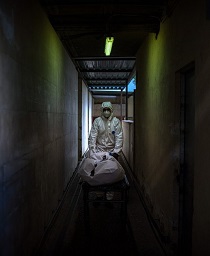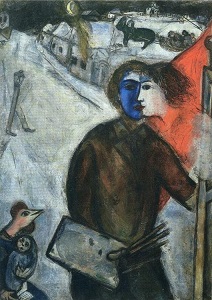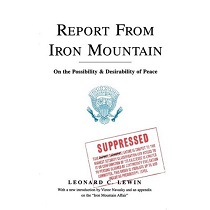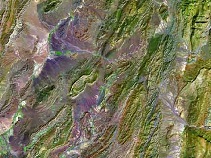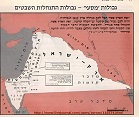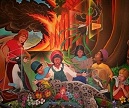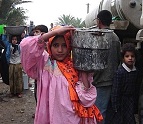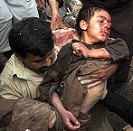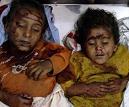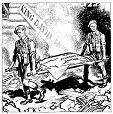A NWO History of Mongolia
David Richards
Henry Makow's Blog

Ban and Mongolian Archer woman
"After an initial settling in period, the Soviets went about destroying Mongol identity. Buddhism was top of their hit list and they murdered 30,000 monks and liquidized over 750 monasteries."
Situated between Russia and China, Mongolia is the least densely populated country in world, with three million people living in a country the size of Western Europe.
Over thousands of years, the Mongol people have perfected a nomadic lifestyle to thrive in Siberian winters, acrid deserts and barren steppes. Despite recent urbanization, half the population continues to live a nomadic lifestyle.
The warring tribes of the region were once merged under the leadership of Genghis Khan and used their innovative military tactics to create the great Mongol empire.
Yet despite their famed indigenous culture, the United Nations classifies Mongolia as a developing country. By 'development', the UN means the integration of Mongolia into a world government.
THE SOVIET ERA
The start of Mongolia's 'development' was a Soviet invasion in 1921, which radically altered Mongol culture and laid the foundations for a modern international state.
After an initial settling in period, the Soviets went about destroying Mongol identity to bring in the new. Buddhism was top of their hit list. They murdered 30,000 monks and liquidized over 750 monasteries.
Their next target was nomadism. Stalin's forces worked to destroy any independence from government. They even went in search of Kazakh groups in the Western mountain regions who hunt prey with eagles, but couldn't track them down.
The plan was to replace nomadic lifestyle with collective agriculture, with all proceeds going to the state.
This was not easy, as Stephen Bodio writes, 'nomads have always valued freedom, and Mongolia has always been a society of nomads. Soviet puppet leader Choibalsan's attempt at collective agriculture failed when rural residents killed their livestock rather than submit.'
The Soviets developed their capital city Ulaanbaatar and brought in the key elements of an international state: a central bank, large bureaucracies and a standardized education system.
The Soviet era was characterized by enormous infrastructure projects building power stations, bridges and highways.
In the 1960's though, Mongolia was still lacking in the facilities to house foreign dignitaries. There were only a few embassies (all Soviet satellites), and significantly, a British envoy. His name was Reginald Hibbert whose job was to chronicle how the people were reacting to Communism
Reginald's observations are found in the book, 'Letters From Mongolia' in which he bemoans the harsh conditions and the inefficiency of the country. He writes the locals are 'accustomed to rhythms of life and work that have nothing in common with those of urban communities, and their way of life is primitive.'
In a passage on Mongol kin values, he elucidates: 'they retain many of the virtues of simple people, especially loyalty and mutual help among family and friends. They will work extraordinarily hard on the impulse of helping a friend or acquaintance but seem to be completely without conscience when it is working for a living or for the general good.'
In other words, working for friends and family is primitive, while working for an impersonal Soviet state is civilized.
"DEMOCRACY"
With the fall of the Soviet Union, Mongolia became a democracy in 1992 but was still crippled by $11 billion of Soviet debt.
Where poverty reigns, the IMF sweeps in like vultures, handing out further loans with strings attached that benefit the global power elite. In 1992, 80% of state enterprises were privatized sinking a population made dependent on government into poverty.
To fill the void left by the removal of Soviet subsidies, loan sharks prowl the frozen wastelands luring nomads into debt.
Even 'charities' like New Zealand's VisionFund offers loans to nomadic people with interest of 2.5%-3.5% a month! VisionFund work to emasculate the men: 85% of loans are given to women.
Through the creation of debt on both a state and personal level, the Mongols are enslaved to alien forces by a paper currency emblazoned with their hero Genghis Khan.
With a central bank, bureaucracies and infrastructure developed by Communism, foreign corporations can now enter Mongolia and mine its vast resources of copper, gold, coal and uranium.
The country is expected to fuel China's growth. Perhaps this was the role planned for the country all along.
WESTERN "CULTURE"
Democracy also brings in the Western culture industry which is designed to erode traditional family values. The intention is to create an atomized populace obsessed with consumerism and entertainment, obediently serving their economic masters.
MTV is very popular in Mongolia and the youth mimic what they see. Take Lumino, a Mongol hip-hop group. Their early songs were light-hearted and innocent, but now inside their videos are sleazy and dominated by gyrating girls dressed like whores.
International governmental agencies also work towards breaking the traditional family. Take a UNESCO scheme called, 'The Gobi's Women's Project,' an educational project designed to emasculate men.
The program 'empowers women' by teaching them, 'livestock rearing techniques; family care (family planning, health, nutrition and hygiene); income generation using locally available raw materials and basic business skills, for a new market economy.'
Haven't these people survived for thousands of years without the United Nations?
The project also aims to direct the social agenda of women by giving a radio to every female. 'Programs are broadcast at times convenient to the women, mostly at evening time. They cover topics of general interest, whilst others are more specific and directly related to the needs of the Gobi women.'
The programs are laced with feminist lesbian propaganda. Safe to say there is no Gobi's men project.
Funded by the taxpayers of the world, UNESCO is global socialism. It creates a scenario where the tax dollars of a Wal-Mart worker in Cincinnati are used to emasculate nomadic herdsmen in Mongolia!
The fall-out of poverty and the take down of traditional Mongol society is reactive. In 2008, rioting followed the general election with cries of a fix. The Mongol parliament was set on fire; five people died and 700 were put in prison.
Grass roots fascism is rising. Tsagaan Khass (White Swastika) is a Mongolian Neo-Nazi group. They portray themselves as patriots standing up for ordinary citizens in the face of foreign invasion and rampant inequality. They respect Hitler for 'preserving racial identity'.
Their empty posturing masks the horror that the roots of traditional Mongol culture have been killed. They wish to destroy the system but if they do what will be left? A void.
CONCLUSION
The story of Mongolia's 'development' shows Communism, democracy and NGO's working towards the same end: a regional plantation under the flag of the United Nations.
In a 2009 trip to Mongolia, UN General Secretary Ban Ki-moon praised the country for being a role model for developing countries, and 'making progress in the fight against poverty.'
And yet, if you visit the bright lights and technological advancement of Ulaanbaatar you will see thousands of gers, the traditional Mongol nomadic house, scattered about the outskirts of the city. Their inhabitants are starving.
In a land with a tradition of self-sufficiency, a third of people now live below the poverty line. Such is the fallout of 'development.'
___________________________________________________________________________________
URL: http://www.a-w-i-p.com/index.php/2010/10/21/a-nwo-history-of-mongolia

